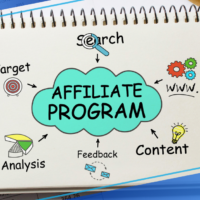Affiliate Marketing Most Common Phrases & Terms Explained

Today, we are talking about abbreviations for the most common affiliate marketing phrases – to help you understand what they mean and why they are important.
As an affiliate marketer, we use a lot of words and phrases that may be confusing to people who are not familiar with the terminology. For example, we use common words like “techniques” and “phrases” but give them different meanings. If you are new to affiliate marketing, this article will help you understand the techniques, phrases, and acronyms used in this field. I will explain them in detail. This can serve as a complete description of affiliate marketing. So, as you move forward, you won’t have to worry about getting confused by the jargon used in this industry.
· Affiliate marketing is a process where you promote someone else’s product in order to earn a commission.
· Affiliate this is you potentially the person that is going to be promoting the product to earn the commission.
· Commission is the payment we will receive for promoting said product
· Super affiliates are affiliates that are incredibly successful and earn the most commissions.
· Vendor is the creator of a product or service of an affiliate program that you are promoting.
· Affiliate program is the agreement between an affiliate and a vendor to promote the product but essentially it is referred to as the actual product.
· Affiliate network is a website that holds multiple affiliate programs such as Impact, clickbank, warrior plus these sorts of places where you can search for specific affiliate programs you can apply to promote them you can find all the information all that sort of good stuff you can also go in and check your commissions and your statistics
· The offer is essentially any of the content that’s been created by the vendor in order to sell the product so we’re talking about essentially the sales part of their website commission rate and this is what you’re going to earn in commissions this can be reflected by a percentage so it could be one percent of the sales price or it could be a fixed rate for bringing in a sale to the affiliate program
· Affiliate link is your unique url to your unique website which when clicked on will go to the sales page or the opt-in page and it is tracked by the vendor or the affiliate network in order to know whether a can be attributed to you so you can earn the commission
· Squeeze page is also commonly called a landing page this is a one page website with the sole intention of extracting a visitors email address usually in conjunction with providing some kind of free gift
· The funnel refers to the entire process that a customer will go through the business and it can include traffic and opt-ins sales processes, upsells being within the ecosystem of the vendors world. The funnel is essentially just referred to as the actual web pages that are utilizing the sales page(s).
· The lead is essentially a visitor who has interacted with a website with the potential to become a customer
· Lead magnet is offering something for free in order to get someone’s email address is called an “opt-in.” You can do this by having a contact form on your website where people can type in their name and then click a button to download or gain access to something you’ve offered.
· Copy is essentially the written words and text that is on a sales page or a squeeze page. In Affiliate marketing your copy should be persuasive and always be trying to get people to take an action
· VSL stands for video sales letter which is a video on a sales page that does the same work as the text, to provide persuasive speech and content in a video format.
· Front end product is the core product because when you are selling a product you may have your product but additional upgrades, add-ons and upsells that can be added onto the front end product.
· OTO stands for one time offer and essentially there are additional upgrades, upsells, add-ons and offers that are presented to a customer immediately after they have made the decision to purchase a product so they can easily click on buy and then it will come up with additional pages that say before you check out we’ve also got these additional upgrades add-ons and upsells that we feel would be beneficial to you. The phrase “ would you like to purchase these as well yes or no” is the key to the process to obtain more revenue per sale. If they click yes we add them to the cart, and with a no we move forward in the cart with just the main product. The key is to keep it simple, with 1 click.
· Clicks refer to the amount of people that click on a link. For example, the amount of people that come to your site.
· Traffic is another one like funnel it’s a word that’s used a lot but we’re talking about something very specific here in affiliate marketing and this is the process of getting people to see or click onto your website so this can be free or this can be paid.
· Paid Traffic is simply paid advertising such as putting advertisements on websites, facebook, youtube, google or emails so people are sent to our link.
· Free traffic is when you have loads of content (on social media, or on your own web site) such as videos on a channel, or SEO backlinks/posts from other web sites. Free traffic is generally the process of driving people you know or who see your content to a specific website without specific cost per click / action.
· Conversion rate is a metric that compares the amount of visitors with the amount of sales and is reflected in a simple percentage
· Click through rate is a metric that compares the amount of people that visit your site with the amount of people that take the specific action that you wanted them to do. That action could be purchasing a product or clicking on the opt-in button with their email, or anything in between. Click through rate is that it’s that comparison between visiting your site and then doing what you wanted them to do.
· Earning per click is the metric compares how much money was made from people who bought the front-end product, and people who bought one-time offers, to how many people visited. This tells you what each visitor was worth on average, whether they bought anything or not.
· Tracking allows you to monitor your website traffic and see important data points such as how many people clicked on your site, how many people clicks through it, their location, and what type of device they were using. This information is valuable in understanding how effective your website traffic has been in terms of success.
· Re-targeting is the process of using code (often called a Pixel, but similar to a cookie) from advertising networks such as facebook so that when someone visits your website they get hit with a hidden cookie. That cookie interacts with this pixel to collect the data so that later down the line you can go to those advertising networks and send specific advertisements targeted just at those prior visitors of your websites and offers. You do this re-targeting because you know what they were interested in already, and have a higher likelihood to be interested in it again (or something similar) which effectively gives you lower cost advertising to achieve higher actioned success (click, click-through, sale, etc).
· Split testing is a process of testing out multiple different pages and offers at the same time to see which is more effective. You have the ability to create two different opt-ins or two different sales pages with different headlines for example or different colors and then utilize software that will automatically switch between the two for different people. Split testing will provide you with data where you can analyze the the tracking and the the click-through rate to the final conversions to see what was most effective. Whatever is most effective you determine from split-testing is one you can then focus more heavily with promotion and advertising to have great profits.
· Niche is another word for the category or a sub category that relates to the interest or issues people within your target audience have. for instance that can be affiliate marketing but then a sub category of that could be pay per click advertising or email marketing.
· Email list is a collection of email addresses that you can get by different methods. For example, you can give away something for free (like a free report or eBook) in order to get people to sign up for your list, or you can sell a product and then collect the email addresses of those who buy it. Once you have a lead list, you can send marketing messages to those people whenever you want.
· Autoresponder is an email marketing service that helps you collect and store email addresses. With this service, you can send preset emails to your list. You can also automate (drip) welcome emails that start to market or sell additional services. You can create a series of emails that go out over time (drip) starting from the first date that someone’s email address is added to the list. The key is that it is fully automatic and has high returns on action once you properly build out some follow up emails in your autoresponder service.
· Affiliate manager is the person who runs the affiliate program on behalf of the vendor or the creator of the product they will source affiliates they will run competitions they’ll do everything in order to make sure that the program with regards to the product works effectively and produces results.
· SEO this stands for search engine optimization and this is essentially the optimization of your website so that it can be found more readily within the google search (and other search engines like bing). The goal is that a potential lead can search a specific word and search engines or social media networks, like Youtube will direct them to your web site, video, or offer(s) byplacing your web site or video higher up the rankings presented when a potential lead searches.
· Key word is essentially a specific word or phrase that you would type into a search engine, social media, youtube, etc to find something specific. In terms of affiliate marketing you closely look at the cost per click (CPC) for key words that you want to advertise and pay for traffic to be pushed to your web site or offer.
· Product launch Launching a new product to the public is often done through an affiliate program. This involves getting many people to promote the product in order to generate traffic and sales. Vendors often provide incentives for affiliates to do well in these launches.
· Affiliate contests and the leaderboards are often tied with product launches to create more interest amongst affiliates where the affiliates will compete to get the most sales to win or earn prizes or cash. When these launches happen (the bigger product launches) you will have the leaderboards where you can see who are the top affiliates and who are those super affiliates that are leading those leaderboards
· CPC is cost per click which is the price you will pay per visitor to an ad network.
· CPA is cost per action which is a slightly different version of affiliate marketing where you get paid a commission for getting a lead to do something very specific such as providing their email address or clicking like on a video. It doesn’t have to be purchasing a product – so this is why cpa offers will earn smaller commissions because you’re getting the visitor to do a lot less
· Exit Pop or Exit Pop Ups Exit intent pop-ups are pieces of code on your website that will create a pop-up if someone tries to leave your website. For example, if someone moves their mouse towards the top of the screen as if they’re going to close the window, or clicks the ‘x’ to close the window, our pop-up will automatically appear and block their mouse. We can use this to try and keep people on our site by offering them special coupons or offers.
Hopefully going forward with the help of this guide you won’t be confused by the unique phrases, words, and jargon used in affiliate marking.






